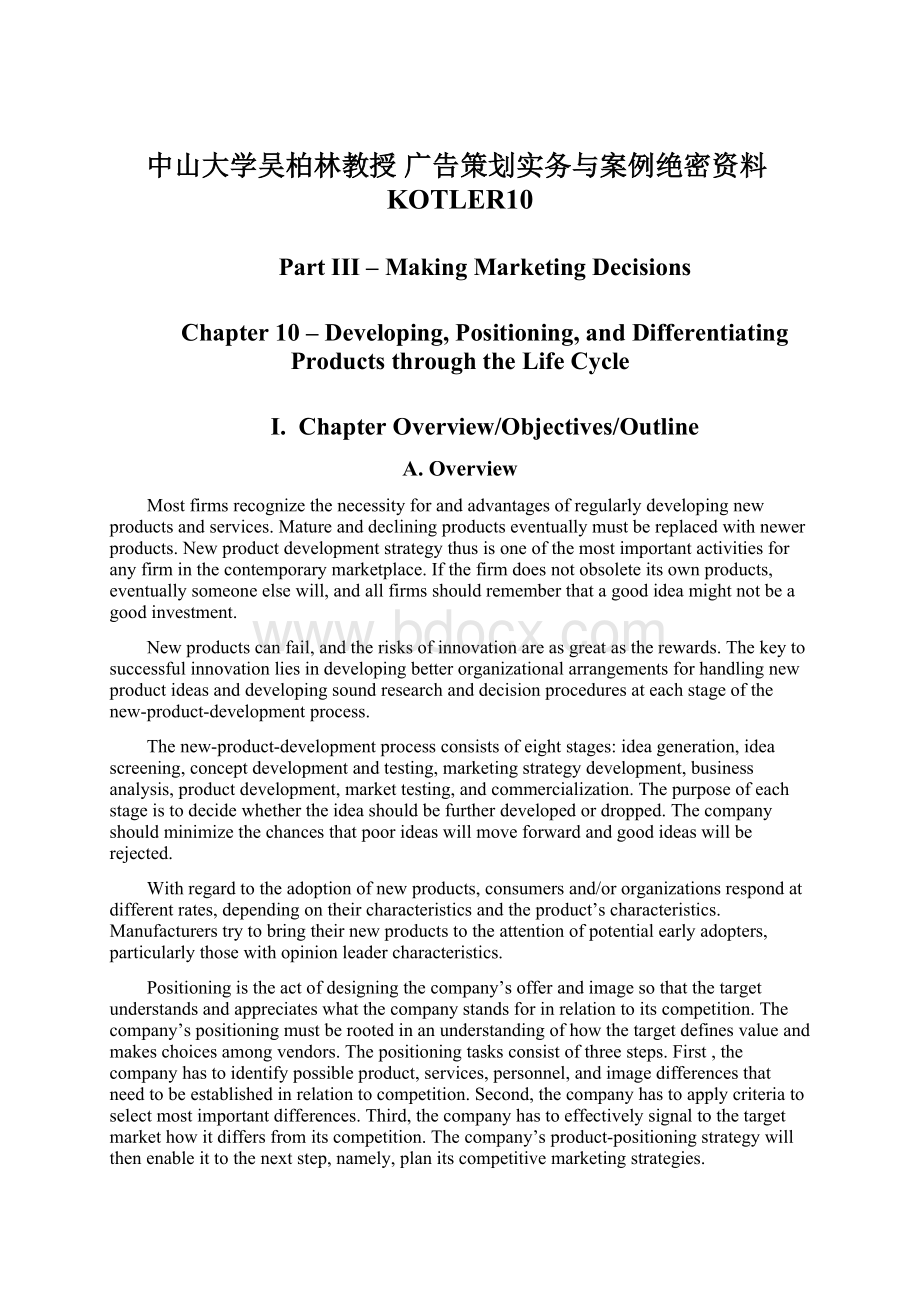中山大学吴柏林教授 广告策划实务与案例绝密资料KOTLER10Word格式文档下载.docx
《中山大学吴柏林教授 广告策划实务与案例绝密资料KOTLER10Word格式文档下载.docx》由会员分享,可在线阅读,更多相关《中山大学吴柏林教授 广告策划实务与案例绝密资料KOTLER10Word格式文档下载.docx(17页珍藏版)》请在冰豆网上搜索。

Newproductscanfail,andtherisksofinnovationareasgreatastherewards.Thekeytosuccessfulinnovationliesindevelopingbetterorganizationalarrangementsforhandlingnewproductideasanddevelopingsoundresearchanddecisionproceduresateachstageofthenew-product-developmentprocess.
Thenew-product-developmentprocessconsistsofeightstages:
ideageneration,ideascreening,conceptdevelopmentandtesting,marketingstrategydevelopment,businessanalysis,productdevelopment,markettesting,andcommercialization.Thepurposeofeachstageistodecidewhethertheideashouldbefurtherdevelopedordropped.Thecompanyshouldminimizethechancesthatpoorideaswillmoveforwardandgoodideaswillberejected.
Withregardtotheadoptionofnewproducts,consumersand/ororganizationsrespondatdifferentrates,dependingontheircharacteristicsandtheproduct’scharacteristics.Manufacturerstrytobringtheirnewproductstotheattentionofpotentialearlyadopters,particularlythosewithopinionleadercharacteristics.
Positioningistheactofdesigningthecompany’sofferandimagesothatthetargetunderstandsandappreciateswhatthecompanystandsforinrelationtoitscompetition.Thecompany’spositioningmustberootedinanunderstandingofhowthetargetdefinesvalueandmakeschoicesamongvendors.Thepositioningtasksconsistofthreesteps.First,thecompanyhastoidentifypossibleproduct,services,personnel,andimagedifferencesthatneedtobeestablishedinrelationtocompetition.Second,thecompanyhastoapplycriteriatoselectmostimportantdifferences.Third,thecompanyhastoeffectivelysignaltothetargetmarkethowitdiffersfromitscompetition.Thecompany’sproduct-positioningstrategywillthenenableittothenextstep,namely,planitscompetitivemarketingstrategies.
Productsandmarketshavelifecyclesthatcallforchangingmarketingstrategiesovertime.Everynewneedfollowsademandlifecyclethatpassesthroughthestatesofemergence,acceleratinggrowth,deceleratinggrowth,maturity,anddecline.Eachnewtechnologythatemergestosatisfythatneedexhibitsademand-technologylifecycle.Particularproductformsofagiventechnologyalsoshowalifecycle,asdobrandswithinthatproductform.
ThesaleshistoryofmanyproductsfollowanS-shapedcurvemadeupoffourstages.Theintroductionstageismarkedbyslowgrowthandminimalprofitsastheproductispushedintodistribution.Thecompanyhastodecideduringthisstagebetweenthefourstrategiesofrapidskimming,slowskimming,rapidpenetration,orslowpenetration.Ifsuccessful,theproductentersagrowthstagemarkedbyrapidsalesgrowthandincreasingprofits.Duringthisstage,thecompanyattemptstoimprovetheproduct,enternewmarketsegmentsanddistributionchannels,andreduceitspricesslightly.Therefollowsamaturitystageinwhichsalesgrowthslowsdownandprofitsstabilize.Thecompanyseeksinnovativestrategiestorenewsalesgrowth,includingmarket,product,andmarketing-mixmodification.Finally,theproductentersadeclinestageinwhichlittlecanbedonetohaltthedeteriorationofsalesandprofits.Thecompany’staskduringthisperiodistoidentifythetrulyweakproducts;
developforeachoneastrategyofcontinuation,focusing,orniching;
andfinallyphaseoutweakproductsinawaythatminimizesthehardshiptocompanyprofits,employees,andcustomers.
NotallproductspassthroughanS-shapedPLC.Someproductsshowagrowth-slump-maturitypattern,othersacycle-recycleshape,andstillothersascallopedshape.SomeinvestigatorshavediscoveredoveradozenPLCshapes,includingthosedescribingstyles,fashions,andfads.Becauseoftheglobalizationofthemarketplace,aninternationalPLCshapehasalsoemerged.ThePLCtheoryhasbeencriticizedbecausecompaniescannotpredicttheshapesinadvance,orknowwhatstagetheyareinwithinagivenshape,orpredictthedurationofthestages.Inaddition,PLCsaretheresultofchosenmarketingstrategiesratherthanindependentofthechosenmarketingstrategies.
Productlife-cycletheorymustbebroadenedbyatheoryofmarketevolution.Thetheoryofmarketevolutionholdsthatnewmarketsemergewhenaproductiscreatedtosatisfyanunmetneed.Theinnovatorusuallydevelopsaproductforthemassmarket.Competitorsenterthemarketwithsimilarproductsleadingtomarketgrowth.Latergrowthslowsdownandthemarketentersmaturity.Themarketundergoesincreasingfragmentationuntilsomefirmintroducesapowerfulnewattributethatconsolidatesthemarketintofewerandlargersegments.Thisstagedoesnotlast,becausecompetitorscopythenewattributes.Thereisacyclingbackandforthbetweenmarketconsolidationbasedoninnovationandfragmentationbasedoncompetition.Themarketforthepresenttechnologywillultimatelydeclineuponthediscoveryofsuperiortechnologies.
Companiesmusttrytoanticipatenewattributesthatthemarketwants.Profitsgotothosewhointroducenewandvaluedbenefitsearly.The’searchfornewattributescanbebasedoncustomersurveywork,intuition,dialecticalreasoning,orneeds-hierarchyreasoning.Successfulmarketingcomesthroughcreativelyvisualizingthemarket’sevolutionarypotential.
B.LearningObjectives
∙Recognizethemainrisksindevelopingnewproductsandthenew-product-developmentprocess.
∙Understandtheelementsoftheconsumer-adoptionprocess.
∙Understandandexplaintheconceptsoftheproductlifecycle(PLC).
∙DistinguishtheconceptsandstagesofmarketevolutionfromthePLC.
∙Theconceptsofpositioningandhowdifferentfirmstrytocommunicatetheirpositioningstrategytothemarket.
∙Howtorelatemarketingstrategytomarketevolution.
∙Howtoidentifycompetitiveadvantagesofspecificproductsinthemarketplaceandhowtodiscerndifferentiationattributes
C.ChapterOutline
I.Introduction
II.ChallengesinNew-ProductDevelopment-Companiesthatfailtodevelopnewproductsputthemselvesatrisk;
atthesametimenewproductdevelopmentisrisky.
A.TypesofNewProducts
1.Newtotheworld,newproductlines,additionstoexistingproductlines,improvementsandrevisionsofexistingproducts,re-positionings,andcostreductions.
B.WhyNewProductsFail—andSucceed
1.90+percentfailurerateintheUnitedStatesandEurope
2.Failures:
Marketover-estimations,poordesign,incorrectpositioning,developmentcosts,andcompetitionfightingback.
3.Successes:
Betterunderstandingofcustomerneeds,higherperformancetocostratio,headstartagainstcompetition,contributionmargin,budget,internalteamwork,andtopmanagementsupport.
II.ManagingNew-Products:
IdeastoStrategy-EightStageProcess
A.IdeaGeneration-Ideascomefromavarietyofsources.Ideageneratingtechniquesinclude:
attributelisting,forcedrelationships,morphologicalanalysis,need/problemidentification,brainstorming,andsynectics.
B.IdeaScreening-Notallideascanbepursued,butmustbesenttoacommitteewheretheyareconsideredeither:
promising,marginal,orareject.Inthisstagethecompanyrunstheriskofeitheracceptingabadideaorrejectingagoodone.
C.ConceptDevelopment-Attractiveideasmustberefinedintotestableproductconcepts.Aproductconceptisanelaborateversionoftheideaexpressedinmeaningfulconsumerterms.
D.ConceptTesting-Productconceptsshouldbepresentedtoanappropriategroupoftargetconsumerstogaugetheirreactions.Customer-drivenengineeringisanengineeringeffortthatattacheshighimportancetoincorporatingcustomerpreferencesinthefinaldesign.Consumerpreferencescanbemeasuredthroughconjointanalysis.
E.MarketingStrategyDevelopment
1.Strategyplan,price,distribution,andbudget
2.Longrunsalesandprofitgoals,marketingmix
F.BusinessAnalysis-Performingsales,cost,andprofitprojectionsontheproposedproducttodeterminesatisfactionofcompanyobjectives.
1.EstimatingTotalSales-Sumofthreedifferenttypesofsales(first-time,replacement,andrepeat)mustyieldasatisfactoryprofit.
2.EstimatingCostsandProfits–Break-evenanalysisandriskanalysis.
III.ManagingNewProducts:
DevelopmenttoCommercialization
A.ProductDevelopment-Representsasubstantialjumpininvestment.Productcontinuestomovethroughfunctionalandconsumertests.
1.Techniquesformeasuringconsumerpreferences-simplerank-ordermethod,pairedcomparison,andmonadic-rating.
B.MarketTesting
1.Consumer-GoodsMarketTesting-leastcostlytomostcostly
a)Sales-WaveResearch-Consumerswhoinitiallytrytheproductatnocostarere-offeredtheproduct,oracompetitor’sproduct,atslightlyreducedprices.
b)SimulatedStoreTechnique-Consumersarequestionedaboutbrandfamiliarityandpreferences,shownadvertisements,givenasmallamountofmoney,andsenttoamockstorewheretherepurchasesarerecordedandanalyzed.
c)ControlledTestMarketing-Organizationsworkwithapanelofstoreswillingtotestmarketaproductforafee.